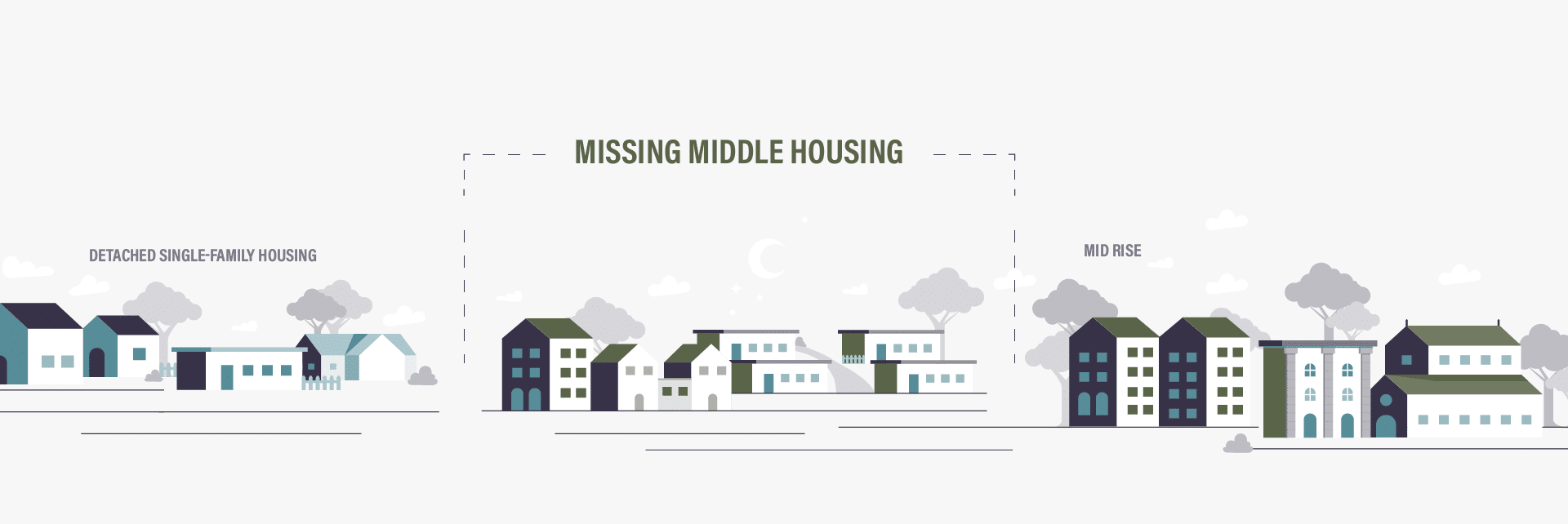Get the Facts on
Missing Middle Housing
The Simple Reforms That Will Make Easton More Affordable for All
Talbot County and the town of Easton face a crisis in housing availability and affordability similar to many cities nationwide, and we need to be proactive in bringing fresh solutions to our community.
- The median home value in Easton is $407,000. However, the average family is making only $75,544 and can’t even afford a home worth $230,000.
- As of January 2024, there are only two homes for sale under $300,000, leading most of Easton’s working families to rent to live within the town limits.
- However, monthly rents have risen to between $1,517-$1,895, still squeezing our middle-class residents.
There is a significant gap between what our neighbors make and what they can afford to purchase or rent in the town of Easton. However, there is a solution that will help bring more lower-cost homes to Easton while preserving the historic character of the town we love.
That solution is reforming our zoning laws to allow for increased inclusion of “missing middle housing”
What is Missing Middle Housing?
Click image to view full graphic
Missing Middle Housing, or housing types that fall between single-family, detached homes and high-capacity apartment buildings, offers housing diversity, availability, and affordability for those looking to move to or stay in the town.
How Will it Mitigate Easton’s Housing Crisis?
The development of middle-family homes, including townhomes, duplexes, and triplexes will accommodate our neighbors in Easton. Access to homes like these will:
- Unify the town’s neighborhoods through a diverse housing mix
- Provide critical housing for those most impacted by housing affordability, including seniors, young professionals, and service members sustaining our community
- Improve access to healthcare services, as development will take place in close proximity to local hospitals
Dispelling the Myths of Zoning Reform
A 2022 housing survey showed many residents share concerns about the lack of housing affordability in the area, and also highlighted common misconceptions about this effort. Below are the latest facts to answer frequently asked questions:
- Myth
- Fact
Zoning reform will change the unique historic character of Easton and Talbot County
Easton currently has many middle-family buildings dating back to the early 1900s. Incorporating more middle-family housing options will bring back its unique historic character, in addition to providing more walkable, livable mixed community neighborhoods.
Adding additional housing units will increase traffic in Easton.
Making it more affordable for our workers to live in Easton decreases traffic coming into the town. With more workers living in the town, they have the option to walk or bike to their place of employment, thus minimizing traffic in the area.
Zoning reform will increase density in the town.
Easton is under capacity, based on the 2010 Comprehensive Plan projection. New middle housing units will be subject to density restrictions, including lot size and height restrictions.
Adding middle-family housing will negatively impact home values in Easton.
There is no indication that middle-family housing would adversely affect nearby housing prices. This housing type enhances home values by replacing vacant, abandoned lots, and brings monetary value to the local economy.
This will adversely impact our infrastructure capacity.
Easton evaluates the adequacy of water supply, roads, sewer infrastructure and more on a project-specific basis prior to, or concurrent with, the planned development of middle-family housing.
Schools will become overcrowded.
Talbot County Schools evaluates future student population based on potential new development. In the past new development has yielded fewer students than anticipated.
Proposed Zoning Reform
Easton’s infrastructure is well-equipped for the development of diverse housing types that maintain the character of the town. This will allow for continued protection of the precious agricultural lands this Chesapeake Bay community is known for, while also providing families and workers with housing they can afford.
The development of missing middle housing, including townhomes, duplexes, and triplexes will accommodate our neighbors in Easton. Housing options like these are essential to our community, the people who serve it, and the economy as a whole. Inclusionary zoning can ease the housing crisis while protecting the agriculture and historic character our community knows and loves.
By taking the right approach to housing development in Easton, residents will gain access to various housing types that will maintain its original charm, while giving teachers, public works employees, firefighters, police officers, nurses, and other essential service workers the access they deserve to quality housing in the community they sustain.
Addressing the Challenge
Making this vision a reality requires cooperation from developers, county officials, regulatory leaders, and residents.
- For developers, this means allocating housing units below market price.
- For officials, this means incentivizing developers to build below-market housing and enforcing inclusionary zoning laws required for multi-family residences.
- For regulatory leaders, this means the reduction of obstacles for developers interested in new building initiatives.
- For residents, this means supporting change to benefit the wider Talbot County community.
Stay informed on this pressing issue.
Sign up to receive communications on zoning reform in Talbot County.
